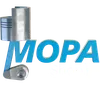TDC-POINTER Display for precise engine monitoring and timing
The article category Display covers robust indicator and HMI components that visualize critical operating data on engines. From compact panel meters to full-size control-room screens, displays convert sensor signals into clear, actionable information for crews and maintenance teams. In heavy-duty applications—such as a marine engine or a large stationary diesel engine—reliable displays are indispensable for safe start-up, accurate tuning, and continuous performance tracking. In particular, a TDC-POINTER display makes the top dead center reference visible and usable, enabling precise timing work during commissioning and service.
Modern engine displays are engineered for harsh environments: high vibration levels, temperature fluctuations, salt-laden air, humidity, and electrical noise. They present RPM, pressure, temperature, alarms, and timing references with high contrast and fast refresh, integrating with control systems via CAN bus, Modbus, or discrete I/O. When operators can read and interpret data instantly—right at the engine or on a bridge console—downtime is shortened and the risk of secondary damage drops significantly.
TDC-POINTER display function in a marine engine or diesel engine
A TDC-POINTER display is a specialized visual aid that shows the crankshaft’s angular position relative to top dead center. On a marine engine or a large diesel engine, it typically receives input from a magnetic pickup or optical sensor that detects a zero index mark on the flywheel and counts tooth pulses to calculate degrees. The display then presents accurate angular data—often as degrees BTDC/ATDC—so technicians can set injection timing, calibrate ignition on gas engines, verify valve events, or align camshaft phasing. By making TDC clearly and consistently visible, the device ensures that timing-related tasks are repeatable and traceable.
In service situations, the TDC-POINTER display may be combined with a strobe indicator or a high-brightness LED bar to improve readability in low light or high-glare engine rooms. Many units include configurable filters to stabilize the reading at low cranking speeds and provide overspeed masking at high RPM. Integration with OEM parts enables correct signal conditioning, noise immunity, and scaling so that the displayed angle matches factory specifications across the full operating range.
TDC-POINTER OEM parts and interfaces
When paired with the correct sensors and harnesses, a TDC-POINTER display communicates seamlessly with the engine’s control network. Typical interfaces include 4–20 mA for speed reference, TTL or VR sensor inputs for tooth counting, and CAN for status and diagnostics. Alarm relays can be wired to alert the operator if the timing reference is lost. For marine-class engines, displays are commonly tested for EMC, shock, and environmental compliance, ensuring stable performance on steel decks near high-current cabling.
Key characteristics and advantages of the Display category
- · High-contrast visualization under harsh, variable lighting.
- · Shock- and vibration-resistant construction for engine rooms.
- · Accurate timing readouts with TDC-POINTER functionality.
- · Compatible with CAN, Modbus, analog, and pulse inputs.
- · Fast refresh for dynamic parameters and alarm states.
- · Sunlight-readable fronts and sealed bezels with high IP ratings.
- · Clear diagnostics to support troubleshooting and commissioning.
Why displays are critical for reliable engine operation
Displays are the operator’s window into engine health. If a TDC-POINTER display drifts out of calibration or becomes unreadable, timing adjustments may be performed at the wrong reference, leading to late or early combustion. The consequences include higher peak firing pressures, elevated exhaust temperatures, increased fuel consumption, detonation on gas engines, and accelerated wear of bearings and pistons. Beyond timing, if general-purpose displays fail to present alarms or trending accurately, crews can miss early signs of lubrication issues, cooling problems, or charge-air restrictions—conditions that shorten service life and raise the risk of unplanned stops.
Consistent visibility is also a safety factor. Clear alarm annunciation and stable, legible values help crews react quickly during maneuvering or load changes. For shipowners and plant operators, dependable displays support compliance with class and environmental regulations by helping maintain correct combustion phasing and emissions control settings.
OEM spare parts suitable for Display: performance, reliability, budget, service life
Choosing OEM spare parts suitable for the Display category—especially TDC-POINTER displays and their sensors—safeguards the entire timing chain. Mechanical fit, connector pinouts, input thresholds, firmware, and calibration curves are aligned to the engine builder’s requirements. That alignment preserves measurement accuracy, reduces setup time, and minimizes the risk of intermittent faults that are difficult to diagnose offshore or in remote plants.
From a budget perspective, correct selection means shorter downtime and fewer repeat interventions. Displays that match OEM specifications maintain EMC robustness and environmental sealing, reducing premature failures caused by condensation, salt mist, or electrical interference. Over the lifecycle, this translates into stable performance, predictable maintenance windows, and lower total cost of ownership while maintaining the performance envelope defined by the engine manufacturer.
MOPA: fast, secure supply of OEM parts for TDC-POINTER displays
MOPA is an experienced and reliable partner for OEM spare parts in the Display category, including TDC-POINTER solutions for diesel and gas engines. Customers benefit from short lead times, verified component traceability, and consistent quality across batches—key factors when a vessel’s schedule or a plant’s output depends on swift, right-first-time delivery. MOPA supports purchasers and technical teams with precise part identification, documentation, and packaging suitable for global logistics, ensuring that the correct display or sensor reaches your engine room without delay.
Whether you operate a blue-water fleet or a high-load power plant, MOPA focuses on speed, quality, and security in the trade of OEM parts—so your monitoring and timing displays perform as expected from installation through long-term operation.
Conclusion: TDC-POINTER displays keep engines precisely tuned
TDC-POINTER displays are vital tools for accurate timing and dependable monitoring on marine and stationary engines. Selecting OEM spare parts suitable for Display ensures correct fit, reliable readings, and long service life—protecting performance and budget while keeping critical equipment safely within spec.

